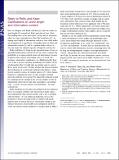Reply to Reilly and Kean: Clarifications on word length and information content
Author(s)
Piantadosi, Steven Thomas; Tily, Harry Joel; Gibson, Edward A.
DownloadPiantadosi-2011-May-Reply to Reilly and Kean Clarifications.pdf (434.2Kb)
PUBLISHER_POLICY
Publisher Policy
Article is made available in accordance with the publisher's policy and may be subject to US copyright law. Please refer to the publisher's site for terms of use.
Terms of use
Metadata
Show full item recordAbstract
First, we disagree with Reilly and Kean ( 1) that our results on word length ( 2) contradicted Zipf's principle of least effort. Our findings were in the same spirit, except that we measured effort in a more principled way than Zipf could have ( 2). Assigning word length by information content is least effort under an assumption of a superlinear relationship between effort and information content ( 3), and it is optimal under a desire to stay just under the channel capacity of linguistic systems ( 4).
Date issued
2011-05Department
Massachusetts Institute of Technology. Department of Brain and Cognitive SciencesJournal
Proceedings of the National Academy of Sciences of the United States of America
Publisher
National Academy of Sciences (U.S.)
Citation
Piantadosi, S. T., H. Tily, and E. Gibson. “Reply to Reilly and Kean: Clarifications on word length and information content.” Proceedings of the National Academy of Sciences 108 (2011): E109-E109. ©2011 by the National Academy of Sciences.
Version: Final published version
ISSN
1091-6490